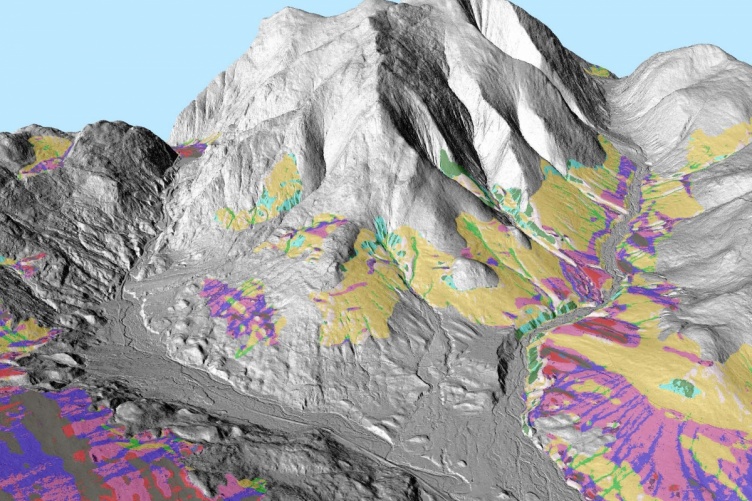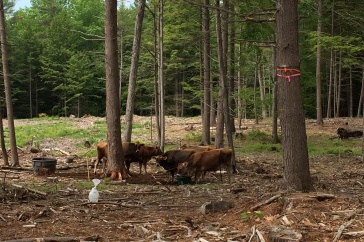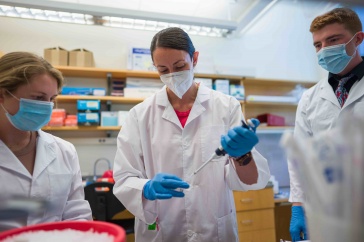
Researchers are using high-resolution Light Detection and Ranging, called LiDAR, images and the application of the Arc Soil Inference Engine for mapping. Credit: AndyColter/UNH/USDA Forest Service
Faculty and graduate student scientists, and alumni from the University of New Hampshire were among those recognized recently for their work in helping conserve the White Mountain National Forest. The Two Chiefs Partnership Award is a national honor given annually by the chief of the USDA Forest Service and the chief of the USDA Natural Resources Conservation Service in recognition of partnership efforts that promote landscape conservation across jurisdictional and resource boundaries.
“The study strives to better understand our environment and the ecological processes that influence current and future land management decisions here in New Hampshire and across broader landscapes of the eastern United States,” White Mountain National Forest Supervisor Tom Wagner said.
Mark Ducey, professor of forest biometrics and management; Tom Lee, associate professor of forest ecology; and Michael Palace, research associate professor of environmental science and remote sensing of biometric properties, were among those honored Tuesday, May, 19, 2015, with the Two Chief’s Partnership Award. Ducey and Lee are researchers with the New Hampshire Agricultural Experiment Station in the UNH College of Life Sciences and Agriculture, and Palace is a researcher in the UNH Institute for the Study of Earth, Oceans, and Space (EOS).

In addition to the UNH researchers, the following collaborators also were recognized: Robert Long, Natural Resources Conservation Service soil survey office leader; Jessica Philippe, Natural Resources Conservation Service soil scientist; Roger DeKett, Natural Resources Conservation Service soil specialist; Martha Stuart, Natural Resources Conservation Service soil scientist who graduated from UNH in 1976 with a bachelor’s in soil science; Scott Bailey, USDA Forest Service Northern Research Station research geoecologist who graduated from UNH in 1984 with a master’s in hydrology; Gregory Nowacki, USDA Forest Service Region 9 regional ecologist; Andy Colter USDA Forest Service, White Mountain National Forest soil scientist and ecologist, and a doctoral student in the UNH Natural Resources and Earth Systems Science Program; and Erica Roberts, ecologist with the USDA Forest Service, White Mountain National Forest, who graduated from UNH in 2004 with a bachelor’s in environmental conservation and in 2010 with a master’s in forestry.
Colter is the lead researcher on the project, which he is conducting as part of his doctoral work at UNH. The partnership, which was established in 2011, aims to increase the understanding of soil, site, and vegetation relationships in the White Mountains.
“These relationships are important for the ecological management of the national forest. They can help identify productive capacity and plant communities across the landscape, and assist in the development and execution of land management and conservation plans and projects,” said Ducey, who is Colter’s PhD advisor.
Specifically, the research team is identifying Terrestrial Ecological Units (TEU) and working to develop Ecological Site Descriptions (ESD) in a 20,000-acre watershed in the White Mountain National Forest. Terrestrial Ecological Units and Ecological Site Descriptions are used in conservation and forestry management to help provide a standardized mapping and classification of habitat diversity and landscape conditions.
“These products will help fulfill the forest’s basic need for land capability information for developing and executing land management plans. The project validated the use of cutting-edge technologies for mapping TEUs and ESDs. These new tools consisted of acquiring high-resolution Light Detection and Ranging, also called LiDAR, images and the application of the Arc Soil Inference Engine for mapping,” Colter said.
“This multi-agency partnership fostered the combination of limited resources through cost-sharing to achieve a common goal with maximum efficiency. We hope this partnership lays the groundwork for future TEU/ESD projects across the eastern United States,” he said.
Founded in 1887, the NH Agricultural Experiment Station at theUNH College of Life Sciences and Agriculture is UNH’s original research center and an elemental component of New Hampshire's land-grant university heritage and mission. We steward federal and state funding, including support from the USDA National Institute of Food and Agriculture, to provide unbiased and objective research concerning diverse aspects of sustainable agriculture and foods, aquaculture, forest management, and related wildlife, natural resources and rural community topics. We maintain the Woodman and Kingman agronomy and horticultural farms, the Macfarlane Greenhouses, the Fairchild Dairy Teaching and Research Center, and the Organic Dairy Research Farm. Additional properties also provide forage, forests and woodlands in direct support to research, teaching, and outreach.
-
Written By:
Lori Tyler Gula, PhD | NH Agricultural Experiment Station | lori.gula@unh.edu | 603-862-1452

















































